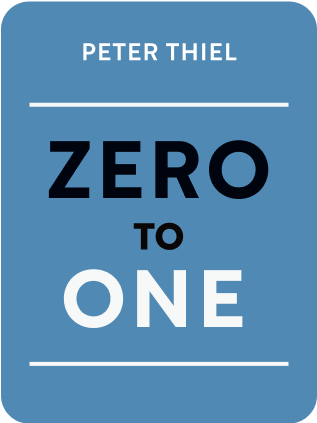

This article is an excerpt from the Shortform summary of "Zero To One" by Peter Thiel. Shortform has the world's best summaries of books you should be reading.
Like this article? Sign up for a free trial here .
What is the last mover advantage? Why do you want to be a last mover, and how can being one help you succeed?
The last mover advantage is when a company is the last to introduce a new product or service and benefits from existing recent innovations in technology. The last movie advantage is that you become the one who makes the last and most spectacular innovation. And in Zero to One, that’s what you want.
The Last Mover Advantage: Why It Works
The “first mover advantage” means getting into a new market first and gaining a substantial share of the market before anyone else gets there.
But moving first is a tactic, not a goal.” Your goal is to generate cash flows for the future. You do this by starting with a small slice of the market (being the first mover) and gradually expanding, dominating each new slice until you own the ultimate market for your product. You want to be the last mover—the one who makes the last spectacular improvement in a market that ensures years of monopoly profits.
Being a first mover puts you in position to be the last mover, gaining the last mover advantage.
Expanding With the Last Mover Advantage
Once you’ve dominated a small market, slowly expand into related markets that are a bit wider.
This was Amazon’s approach. Jeff Bezos’s long-term goal was to dominate online retail, but he chose to start by selling only one thing—books. Amazon quickly became the dominant source of books for people who didn’t live near a bookstore or who wanted books not available in their area.
After a successful start with books, Amazon’s options for scaling up were to either increase the number of book customers (readers) or expand into similar markets. The company began selling CDs, videos, and software and gradually expanded to other categories until it became the dominant online retailer.
eBay also started small, focusing first on Beanie Baby collectors, then moved on to other collectors and hobbyists before ultimately becoming the top auction marketplace for selling something online. However, eBay learned there are limits to scale. It found that the auction model worked better for selling distinctive products like coins and stamps than for commodity items like pencils, which were easier to buy on Amazon than to bid for on eBay. eBay is still a successful monopoly, although smaller than originally envisioned.
Don’t Be a Disruptor
“Disruption” continues to be a buzzword in Silicon Valley, but for startups, the concept can limit or distort your thinking and thus undermine success.
Originally, disruption meant the strategy of using new technology to make and sell a product cheaply, then gradually improve it and surpass high-end versions sold by competitors using older technology. PCs disrupted the market for mainframe computers; at first they seemed insignificant, but they eventually displaced mainframes. Similarly, mobile devices are disrupting the market for PCs.
However, the term disruption has since come to mean little more than changing or improving something. When entrepreneurs think of their companies as disrupting a market, they’re focusing on things as they currently are, rather than coming from a new perspective. It’s far more important to focus on the new product you’re creating than on how old companies will react to it. If your company is fixated on disrupting existing companies, then it isn’t entirely new and isn’t likely to become a monopoly.
Disruptive companies also get into losing battles. For example, in 1999, Napster tried to disrupt the music recording industry but ultimately ended up in bankruptcy.
While some might view PayPal as disruptive, it didn’t challenge an existing company. PayPal took some business from Visa initially, but it actually ended up helping Visa by expanding the market for online payments overall. PayPal created a positive dynamic, while Napster aimed to eliminate an industry.
As you expand your startup into related markets, don’t try to be a disrupter. Instead, avoid competitive markets. It’s much more helpful to have the last mover advantage.
The Last Move Advantage and Technology of the Future
To get the last mover advantage, you have to be aware of changing technology. A Forbes magazine headline once asked: “Will a machine replace you?” But there’s nothing to worry about because computers complement human abilities—they don’t substitute for humans. In the future, the most valuable businesses will be the ones that use technology to help and empower people to do things better, not replace them.
Humans can replace or substitute for each other as a result of globalization—for instance, Indian, Chinese, or Mexican workers can replace American workers in manufacturing and customer service.
However, the challenge of the future won’t be labor competition between countries, it will be competition for resources. People in all countries will demand more comforts as their countries develop through globalization and their basic needs are met. The answer to competition for scarce resources is technology that helps people live better.
People and computers are good at different things. People excel at making plans and decisions in complicated situations; they’re not as good at analyzing huge amounts of data. In contrast, computers excel at processing data, but can’t make judgments that are easy for humans. The last mover advantage in new tech goes to businesses that can enhance human experience.
The different capabilities of humans and computers mean that we can gain more from working with computers than from trading with other people. Other people are like us and do what we do; in contrast, technology helps us do more. People substitute; technology enhances.
The last mover advantage can help your company thrive. If you carefully plan your startup, you can benefit from the last mover advantage.

———End of Preview———
Like what you just read? Read the rest of the world's best summary of Peter Thiel's "Zero To One" at Shortform .
Here's what you'll find in our full Zero To One summary :
- Why some companies genuinely move the world forward when most don't
- How to build a company that becomes a monopoly (and why monopolies aren't bad)
- Silicon Valley secrets to selling products and building rockstar teams






